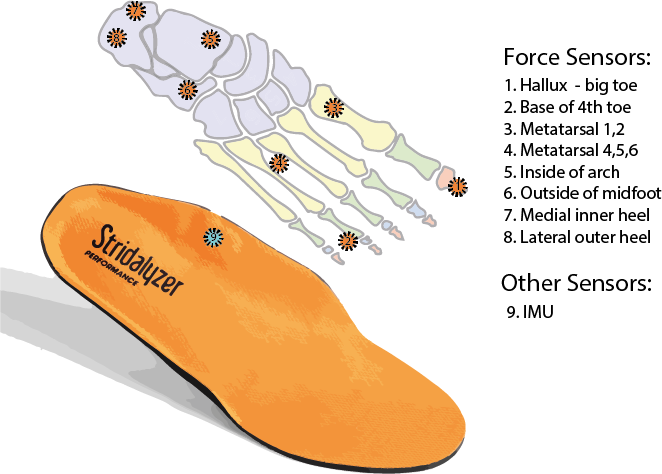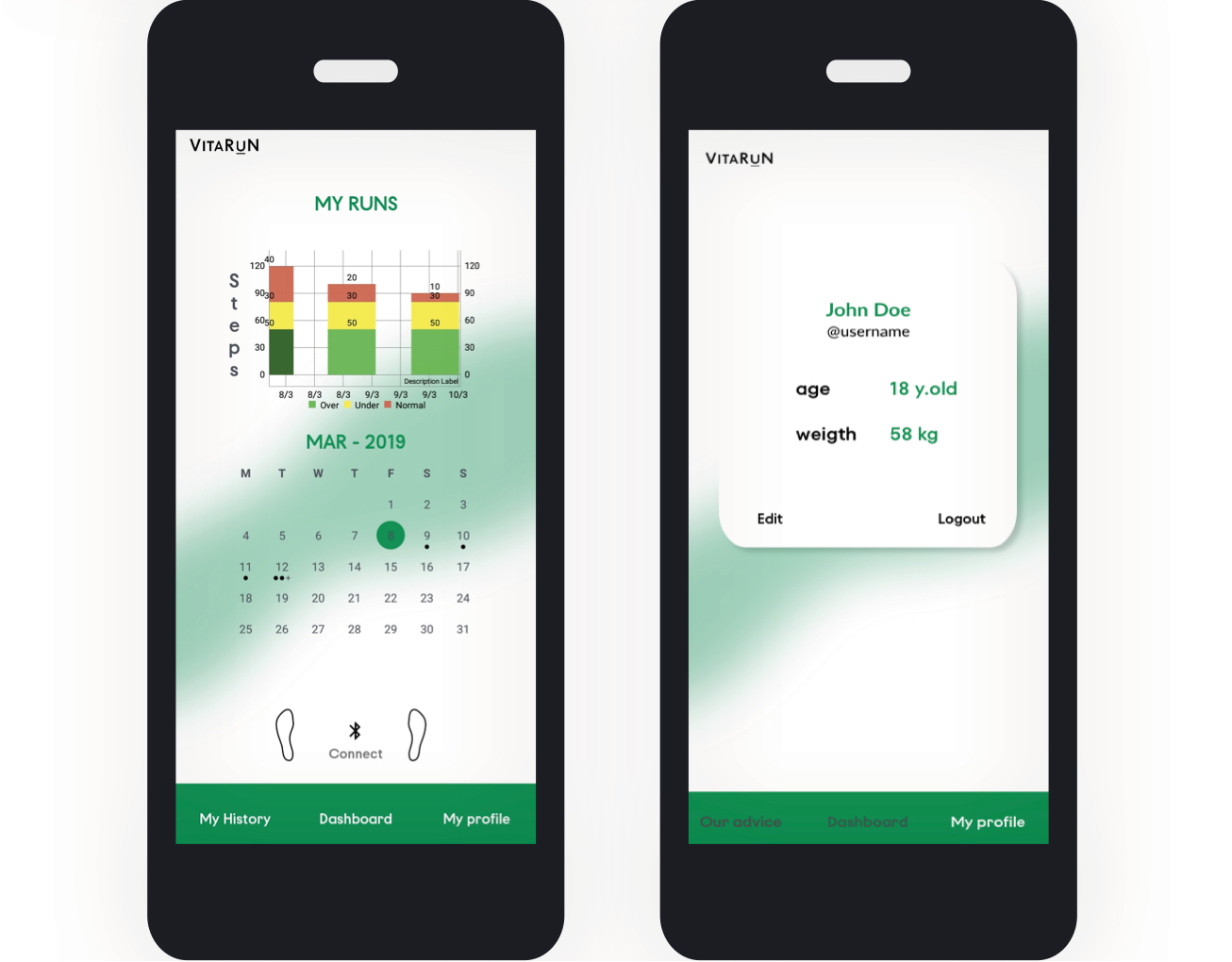VitaRun
Machine learning and mobile healthcare
2019 - Group Project with Jonny Midgen, Alex Gourlay, Benjamin Pheipher, Wesley Norbert, Kenza Zouitene
and Luidmila Zudina

VitaRun monitors selected gait features of a runner through force sensors
and an IMU (Inertial Measurement Unit) embedded in an
insole, and provides live actionable feedback during the run.
It also provides insights derived from this data and keep a
history of runs, allowing the user to observe personal trends.
My personal contribution to the project was app development, backend communication and data visualisation.
Background
Running is the most popular sport activity in the UK. However, running injuries affect
1 in 4 amateurs.
Running gait and style is a factor that runners can control to reduce the risk of injury.
Based on research and interviews with a specialist kinesiologist, the following features were selected:

System
During a run, data from the insole sensors is communicated to the VitaRun app via Bluetooth low energy (BLE).
The app sends the data to the server where it is analysed. The results of the analysis and tailored reccomendations
are returned to the app where audio and visual feedback is returned live.
Historical data is also made available to monitor progress.

System Overview.
Hardware
The sensing element of the system was performed by
a pair of ’Stridalyzer’ smart insoles, purchased from the
manufacturer Retisense. Each insole contained
8 pressure sensors and a 6 axis IMU.

Insole sensors
The data from these sensors were streamed to the app using BLE.
App
App Architecture: The app was developed in Android
Studio and constructed in separate modules called
’fragments’ which each provided a core UI function.
This architecture
allowed team members to work individually on components
without editing the same scripts concurrently.
UI Design: The context of use, the intuitiveness and
ease of implementation were considered during the design
of the User Interface (UI). An initial mock up was made
to describe the app flow from a users perspective and to
predetermine the app architecture that was implemented in
Android Studio. The app wireframes were developed using
AdobeXd which allowed for dynamic prototyping.
Feedback: Every 15
seconds, the Recommendations Fragment requests the data
from the server, it then passes the string to a method that
takes the string and updates the VitaRun UI to give live
recommendations to the runner. The audio feedback is a
cut-down version of the method with only the stride length
recommendations being read out every 4 minutes by a textto-
speech converter. The aim is to inform the user during
their run and not distract them. The audio feature transfers
the interesting information to the user without needing them
to stop to get access to the stride length recommendation.
Data Visualisation: Part of the user feedback is a
visualisation of historic runs. This feature is a useful tool
that allows the observation of trends in pronation over
time, monitoring the progression of the condition and the
effectiveness of intervention.
Back End
The back end tasks can be categorised into user profiles
management, signal processing and pronation type classification.
They are performed on the server. The server was written
in Python and communicated with the mobile application
through a RESTful (Representational State Transfer) API.
Each buffer of samples is sent in JSON format from the app
to the server via a POST method. The server then computes
the step frequency of the current buffer, and accumulates a
longer secondary buffer of data which is used for dividing
samples into steps and identifying the pronation type. GET
requests are then used to return data as JSON files to
the application. The server was local, which made it only
accessible from within the same Wi-Fi network.
Signal Processing
Machine learning was used to identify pronation type live using
from the insole data.
Each step of a run is
classified as ”normal”, ”over” or ”under” pronation types.
Classification is performed by an LSTM (Long Short-Term
Memory) RNN (Recurrent Neural Network), trained on data from the insoles.
Step Frequency was calculated using a fast fourier transform (FFT).
Impact Force was calculated directly from the force sensors.
Conclusion
In conclusion, this project has successfully designed a
mobile application to help amateur runners prevent injuries
by giving feedback on their gait and stride frequency. This
feedback is given given before, during and after the run.
The system includes insoles, the android application and the
server.
VitaRun’s future work includes including traditional features
that competitor running applications have, for example
distance travelled and GPS tracking of running path. As well
as making all information inside VitaRun asymmetrically
encrypted. These two features will enable VitaRun to be a
more complete product for all runners.






